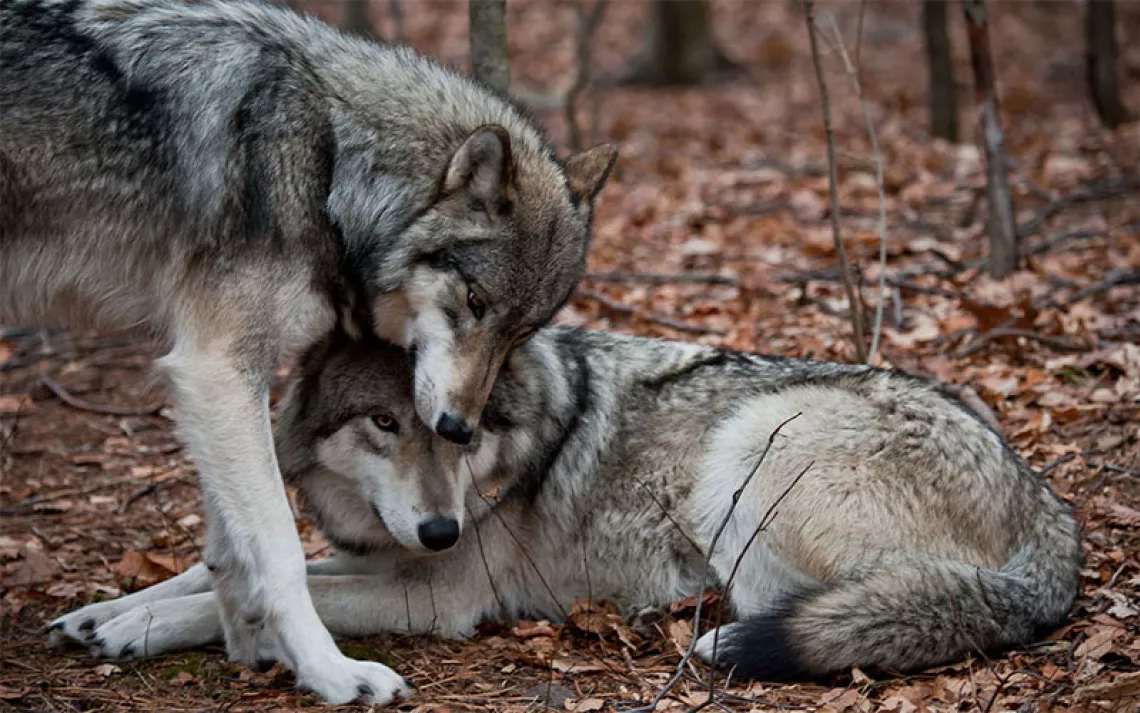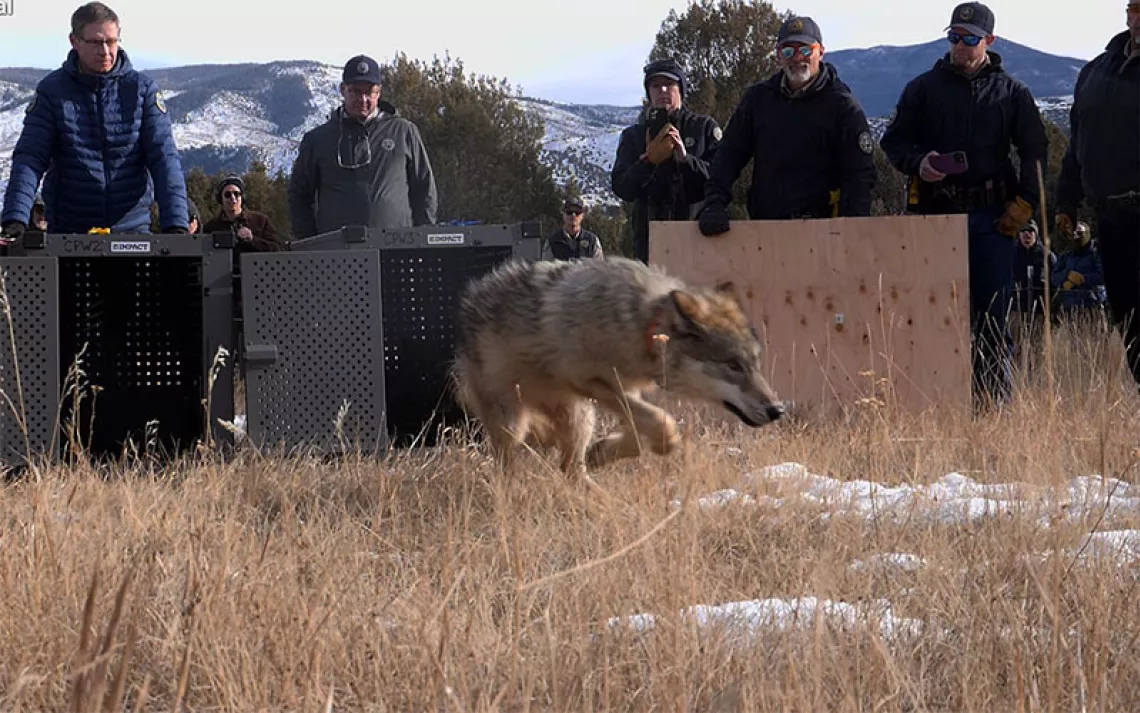New Hope for the Red Wolf?
For the first time in years, the species’ numbers have increased in the wild

Potential mate M2236 being transported to North Carolina | Courtesy of the Wolf Conservation Center
ShowMe and Imani were ready to be pioneers. They cooperated with others in their pack, ate prey that had been hit by cars, and stayed away from people—all useful traits for surviving in the wild.
In late April, the two-year-old red wolf siblings traveled via charter flight from the Endangered Wolf Center in Eureka, Missouri, to northeastern North Carolina. Once fitted with radio-tracking collars, they were settled into acclimation pens and paired with potential mates. Not long after, the four were released in the Alligator River and Pocosin Lakes National Wildlife Refuges. It’s the first time since 1998 that captive-born adult red wolves from managed care facilities have experienced life in the wild.
This spring has been an important time for America’s endemic wolf, one of the country’s most critically endangered species. Until April, only 10 red wolves were known to still be alive in a five-county area in North Carolina. No wild litters had been born for two years. But after discovering a new wild litter this season, the US Fish and Wildlife Service (USFWS) slipped four captive-born pups into the den. The mother accepted the newcomers as her own.

Wolf pups from Akron Zoo being placed in a foster den | Photo courtesy of USFWS
Life in the wild for the country’s most imperiled wolf is fraught with danger. This was made painfully clear with the news on June 9 that the potential mate for ShowMe had been found dead, most likely struck by a vehicle. Nevertheless, between the three remaining adult wolves and the four fostered pups, the wild population has increased significantly. “These animals represent hope for the future of the species,” says Regina Mossotti of the Endangered Wolf Center, who helped introduce ShowMe and Imani to their new home.
Though it’s a big moment for the US zoos, wildlife sanctuaries, and other facilities that tend to roughly 250 captive red wolves, some advocates emphasize this release needs to be the first step, not the last. “It’s important to remember that these releases occurred because of a court order,” says attorney Ramona McGee with the Southern Environmental Law Center, which sued USFWS on behalf of three conservation groups. “This case is not over yet. This is just the start.”
McGee’s organization sued USFWS in November, alleging the agency violated the Endangered Species Act by forbidding previously successful management techniques to boost the wild red wolf’s numbers. These include pup fostering, which USFWS last pursued in 2014. The plaintiff groups also asked for emergency action to ensure red wolves would be released while the litigation continued.
Judge Terrence Boyle ruled in January that the agency “likely” violated the Endangered Species Act and ordered USFWS to develop a plan for red wolf release. USFWS said it would release one pair of adult wolves. The Law Center filed a legal protest, and USFWS, in an amended plan, upped its promise to two pairs.
To be sure, releasing adult red wolves can pose more challenges than pup fostering. To give the wolves an optimal chance to acclimate to new surroundings, it’s best to skip summer because of the heat and October through December because of hunting season, says Kim Wheeler, executive director of the Columbia, North Carolina–based Red Wolf Coalition.
Ideal scenarios include releasing an established captive-breeding pair without a current litter or a pregnant female with her mate. Advocates say, though, that waiting for ideal conditions is a luxury for a species on the brink of extinction.

Staff with the Endangered Wolf Center Transporting a red wolf | Photo courtesy of the Endangered Wolf Center
The slow pace of red wolf recovery in recent years might come down to pressure from some private landowners near the 1.7-million-acre red wolf recovery area who don’t want wolves on their property.
“I wish I understood USFWS's reluctance to do more to save the red wolf, but I do not,” says Collette Adkins, senior attorney for the Center for Biological Diversity, which sued USFWS over the issue in 2019. “Red wolves, unlike gray wolves, pose almost no threat to livestock. Support for red wolves is high in North Carolina, including from the governor's office. I just don't know why a handful of outspoken anti-wolf landowners has so much influence on this federal agency.”
In a statement, USFWS said it is committed to recovering the wolf and cited “widespread misinformation about this species” as a challenge. “We want to change the red wolf narrative to reflect the cultural, historical, and ecological importance of this species. This is not an easy task and may take many decades of trial and error,” said Jennifer M. Koches, USFWS public affairs specialist.
“Recovery of the red wolf is different and potentially more complex than that of the gray wolf, where there are large swaths of public land,” Koches said. “The red wolf occurs in a landscape that has a patchwork of land-ownerships, raising even higher the importance of (the) human dimension aspects of any road to recovery. We need to work together to provide the right environment for their success.”
For her part, Wheeler has worked closely with USFWS field staff and says “they are as committed individuals as you could ever find on the face of this Earth. I just think that management and the field staff have not always seen eye to eye on what needs to happen.”
Given the political and ecological challenges, do red wolves have a realistic chance of being successfully reestablished in the wild? USFWS and advocates will closely monitor how the current population fares. The year also holds other upcoming milestones to help answer that question: USFWS must give a status report on wolf recovery efforts to the court by August 15, and in November, parties in the SELC lawsuit will appear before the court to provide updates on current and any future wolf releases.
Beyond all that, USFWS is still required to create a comprehensive Red Wolf Recovery Plan by February 2023. Mossotti of the Endangered Wolf Center is among those eager for USFWS to identify at least one other area in the southeastern US, the wolves’ historic range, where they could be released. As the only large carnivore native solely to the US and a key part of the ecosystem, the red wolf is “our national treasure,” she says. “This is our wolf.”
 The Magazine of The Sierra Club
The Magazine of The Sierra Club



